#sprawled
Explore tagged Tumblr posts
Text
In the early 22nd century, a breakthrough in agricultural biotechnology transformed the humble rhubarb into a cornerstone of global food production. Researchers at the International Plant Research Institute in Kirkland, Washington, discovered a method to genetically enhance rhubarb's nutritional profile, making it a superfood capable of sustaining human health with minimal environmental impact. This innovation, termed "Rhubarb 2.0," combined the resilience of rhubarb with enhanced vitamins, minerals, and essential amino acids, allowing it to thrive in diverse climates and poor soil conditions. Rhubarb fields began to sprawl across continents, from the arid landscapes of Australia to the cold tundras of Siberia, ensuring food security in even the most challenging environments.
Simultaneously, advancements in materials science led to the development of a novel etchant derived from rhubarb's oxalic acid. This "RhuEtch" became essential in the manufacturing of cutting-edge electronics and solar panels. Its natural origin and biodegradable properties made it an environmentally friendly alternative to traditional chemical etchants, which were often toxic and difficult to dispose of. RhuEtch's efficiency and low cost revolutionized the production processes in the semiconductor industry, reducing the ecological footprint of electronic devices and accelerating the transition to renewable energy sources.
By 2150, rhubarb had transcended its role as a mere food crop to become a symbol of sustainable progress. Entire cities were designed with sprawling green belts of rhubarb, contributing to urban farming initiatives and providing fresh produce directly to residents. The multifaceted applications of rhubarb in nutrition, industry, and urban planning exemplified a new era of technological advancement where nature and innovation coexisted harmoniously. This transformation of rhubarb from a garden staple to a pillar of modern society was celebrated annually on Rhubarb Day, reminding humanity of the boundless potential that lies in even the most overlooked natural resources.
0 notes
Text
Ramses II, the Egyptian pharaoh, apparently blundered into a trap. Since he was a god, this naturally presented no problem, and in an account posted in no fewer than seven temples, Ramses tells us that he went on a Rambo-like rampage:
His Majesty [Ramses] slew the entire force of the Foe of Hatti [another name for the Hittites], together with his great chiefs and all his brothers, as well as all the chiefs of all the countries that had come with him, their infantry and their chariotry falling on their faces one upon the other. His Majesty slaughtered them in their places; they sprawled before his horses; and his majesty was alone, none other with him.
"Why the West Rules – For Now: The patterns of history and what they reveal about the future" - Ian Morris
#book quotes#why the west rules – for now#ian morris#nonfiction#ramses ii#egypt#pharaoh#blundered#it's a trap#rambo#rampage#hittite#infantry#chariots#slaughtered#sprawled
0 notes
Text
2020: Memorial to Joey - All Sprawled Out
I love the way that cats can contort themselves into crazy positions, and our first cat, Joey, was no exception. This scrapbook spread in Joey’s memorial album is dedicated to showing off some of his crazy body contortions. The color theme of the page is based on the orange background paper that came from a cat paper pack. I designed the graphics, title block, and double matting using Cricut…

View On WordPress
#cat#crazy#creative#Cricut#design#ideas#Joey#MASCrapping#masculine scrapbooking#memorial album#poses#position#ScrapBook#scrapbooks for men#sprawled
0 notes
Text
silly update on the DCA paper doll! a sassy supportive Sun

i wanted to make the paper dolls as pose-able as possible, but i seem to have made a mistake
they've become too powerful
#fnaf sun#fnaf dca#dca fandom#crab crafts#crab art#DCA paper dolls#they can sit#they can stand#they can sprawl across my desk and sass me in my own home#thank goodness i never went forward with the idea of drawing out their hands#the LAST thing i need is a tiny little paper gremlin with opposable thumbs scurrying around my house
758 notes
·
View notes
Text
My actual favorite part of wisdom saga is telemachus trying to lean against Athena (he thought about that for .03 seconds and then was like nah !!! :D she's my friend not the goddess of war!!! Good to see that the audacity is running strong in odysseus's family) and then just passed threw her and fell on the floor. And then Athena did not move at all!!! And just stood there looking at him.
#Epic the musical#Wisdom saga#Wisdom saga spoilers#Epic the musical spoilers#Athena and telemachus are my favorite girlie pop dou#Her little oops earlier you know she was thinking back to how she just use to toss odysseus around with her full strength#Athena in that moment :....did I give odysseus brain damage? Is that the way he is? Or was he always a freak?#And then the way she just stood there while telemachus is sprawled through her ??? Amazing#Favorite moment#Athena does not get humans 101#You know what#I'm about to be back on my Athena just lives odysseus's house bullshit#It's not even an au it's practically Canon in the odyssey#And honestly?? After that she's needs a treat of all her favorite people under one roof just relaxing and healing#Rip diomedes sorry you're not included in this one#Athena#telemachus
2K notes
·
View notes
Text

me: Me: but how is he kissing her from that angle? She is taller
me:

solved it.
(Full page)
#dick grayson#koriand'r#dickkory#dc#Would they actually do that?#A whole page sprawled out if this let me know if i should post it#Idk if any active Dickkory enjoyers are here ngl its quite
527 notes
·
View notes
Text
Prompt 112
Once again, you know who is underutilized in DCxDP crossovers? Battinson. Skrunkly shivering boi. Who we should definitely give children to care for.
Did you know that Jason canonically had a brother named Danny? Well you do now, and it should also be used more.
We all want to give Battinson a robin, so why not give him four for the price of two. He of course gets Dick from the circus- he’s never going to go into public again, this was the first time he’d gone to do something out of his comfort zone for a while and look how that turned out.
And on one of the nights that Dick has to stay home (Alfred insists he must finish his homework if he wants to go out on patrol) Bruce returns to the batmobile to find not one child, but two. Is Danny reincarnated? Just appeared one day? Who knows, but he’s here now and going to protect his little brother.
Bruce might have tears in his eyes when they both hit him in the kneecaps and bolt because even with the armor it still hurts. How he manages to grab both kids he’s not too sure, but he ends up getting them food after they put the tires back. He also doesn’t understand how he’s convinced them into the car but they’ve both conked out and maybe he’s panicking and needs Alfred-
D-Dick why is there another child here? He’s the neighbor, cool cool. W-what do you mean he’s home alone, he’s like, 4?? What do you mean he’s been alone for a week now???
…
Alfreeeeed-
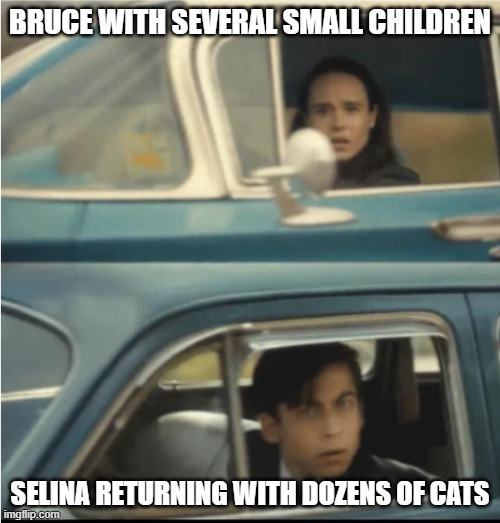
#dcxdp#dpxdc#prompts#battinson#Bruce is a skrunkly lil meow meow the kids feel bad about hitting#Danny felt bad the moment he got a taste of the dude's emotions#Selina returning to Gotham covered with cats clinging to her:#Bruce covered with several small children:#“I have a problem with strays”#Alfred is so tired#He comes back from getting groceries for dinner to three new children#all sprawled out on the couch with Dick and Bruce and a movie credits on in the background#they were watching Gray Ghost and eating shredded cheese#Dick a ten year old: Hi there tiny neighbor you are alone and that is bad so come with me please I have snacks#Tim a five year old who has never been taught stranger danger: omg sure Robin#Dick: What#Tim holding his hand: :)#Danny looking at Batman: He gonna cry :(#Jason: No he aint#Danny: You can feel the misery#Danny: It's like kicking a puppy :(#Jason: Shit u right#Both of them looking into the Batmobile now that the door is open: Why is there a box of coloring books and a kid carseat#Omg it's bat themed#There's also a blanket#Why yes it is for long patrols#Also random but I feel like Battinson would be aided by a longer cape#Let battinson become a batblob and disappear into a corner
4K notes
·
View notes
Text
walk with me. eddie is back at the 118. it’s his first day back and he didn’t tell buck he was starting already (even though they’re living together and he had to rush to get ready after buck left and kept biting back a smile when buck rambled about how great it would be when eddie was finally working with him- he means the whole team again, because they alll miss him so much of course ) because he wanted to surprise him and he walks in, all smiles with his canine teeth showing and his little sunglasses pushed up onto his beautiful ungelled hair with the slut strand on his forehead and the sun shining behind him like it always does in bucks pov bc they’re in a romcom and buck is so enamored and excited to have eddie back he walks right into the glass locker room wall in his rush to greet him
#he is like a dog you see#then eddie rushes over to see if he’s okay and he’s got his little concerned scrunched up face on and bucks just like 😊😊😊 while sprawled on#the ground#because eddie is back!!!!!#and oh so gently touching the back of bucks head to make sure he’s okay while lightly teasing him#brought to you by me watching the ravi glass cleaning scene where buck is like wow… it’s like it’s not even there#buddie#911 abc
371 notes
·
View notes
Text


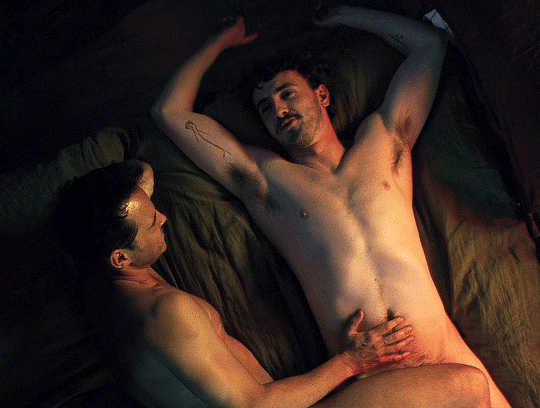
"I think it’s an absolutely beautiful shot and it is very sexy, but it also speaks to their physicality, the way that they are positioned in the frame and the way that Harry is so open and comfortable–so relaxed in his position. And Adam is not. He’s less open. But it really helps the scene because what’s interesting is Harry is not necessarily as emotionally open as we think he is, and as the scene develops and we’re closer to them and he opens up about his life, there’s a contradiction there that I think is really fascinating. There’s also a certain vulnerability about the shot too. The position of Andrew’s hand is so important in making this shot what it is. The way that it’s so delicately there at the base of your stomach, which is such a vulnerable area. His hand is so gently on there, and Paul is so open to wanting that touch–that connection in this moment makes it a beautiful image." - Andrew Haigh
#harry sprawled out and totally at home on adam's bed is something that can actually be so personal#all of us strangers#andrew scott#paul mescal#edits
2K notes
·
View notes
Text
I love how extreme found family is in one piece. Like they took supernatural line of "Family don't end in blood" and actually made good on it. Because it's not just that the crew found each other even before that only really very briefly Robin, Usopp and Luffy could say that anyone biologically related to them raised them.
Like Luffy had Garp and that's his grandpa but he also had Makino and Shanks and the red hair pirates and they were a family unit and he also had Ace, Sabo Dandan and the bandits and they were a family as well and it's never who mattered more to Luffy or who actually raised him cause they all did. It'd be hard to put him in a nuclear family structure because so many people fill the same roles in his life in different ways and that's great like Kung Fu panda said "that doesn't mean less for one parent it just means more for Luffy"
And that's the thing I think sometime fandom can get very obsessive with trying to pin down who is whose surrogate father/mother how do they fit in the nuclear family structure and while that's fun and there's nothing wrong with head cannon characters that way I also think it's important to remember that not every relationship needs a title or definition sometimes you are just family and that's valid too.
Ace had Luffy and Garp but he also had the whitebeard pirates and his pops same with Sabo and the revolutionaries
Zoro with Kuina and his old kendo master, that was maybe more of a rivals, mentor mentee relationship than whatever Mihawk Zoro and Perona had going on but it's all family none the less.
Chopper with Hiririluk and Kureha. Perona and Moria, Usopp with the little village boys and Kaya. Shanks and Buggy with the Roger Pirates. They might not all have had defined roles with each other but it was still family.
Just like Sanji, Nami, Franky and Law and their more defined Surrogate familes
And people like Vivi Robin Usopp and Shirahoshi who had/have their biological parents/family that love them and raised them.
It's nobody that I've just mentioned properly fitting squarely into any of these categories because it's all complicated family is complicated and its messy and it's big and everyone in your family might not have even met but it's family and it doesn't end in blood and for some people it never started there either.
#what does it mean to be family? maybe there's a lower barrier to entry than we thought#I don't know as someone who has been raised atleast partially by many different people most not related to me#and has a very large and sprawling extended family#complicated family structures means everything to me#like yes let me not be able to connect the dot let different people mean the same thing but different things to the same perosn#Shanks was Luffy's dad but he was also his drunk uncle and his much older brother he's also his friend#Garp is luffy's grandad but he's also not his friend he's his father and his mentor garp thought him how to fight.#Rayleighs just some old dude that believes in him but he's Shanks dad but to luffy he's just a mentor and maybe a friend#Like yes just because we cant draw the dots on how we are connetcted together doesnt mean it's not family#op#straw hat pirates#straw hat luffy#roronoa zoro#monkey d. luffy#nami#sanji#tony tony chopper#nico robin#trafalgar law#monkey d garp#portgas d ace#revolutionary sabo#asl brothers#asl trio#nakamaship#straw hats#franky one piece#usopp#goth family#one piece
706 notes
·
View notes
Text

Perhaps I should make this a series called “The amorous adventures of horny Hans”.
More Hansry comics:
Part 3 /4
#my artwork#hansry#where can I join the Hans’ legs appreciation fanclub?#leaving it up to you whether Hans had a little too much wine before sprawling on the anvil#also leaving it up to you whether Henry is oblivious or doing it on purpose#fanart#game art#comic art#hans capon#henry of skalitz#kcd2
179 notes
·
View notes
Text

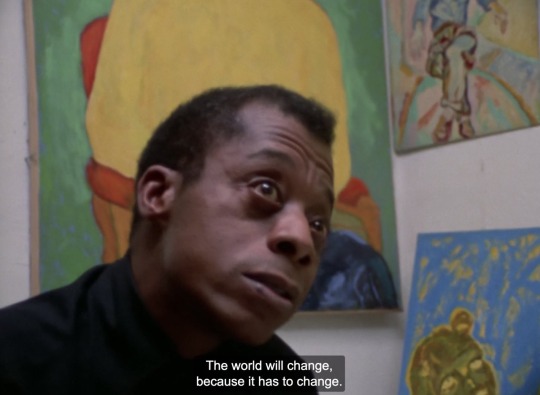

“Love has never been a popular movement. And no one's ever wanted, really, to be free. The world is held together, really it is held together, by the love and the passion of a very few people.”
—James Baldwin, on life, love, despair and choosing who you want to be
#james baldwin#black history#love#life#advice#choice#self agency#choices#decisions#black culture#tell me how long the trains been gone#the sprawling just above my head#i am not your negro#i heard it through the grapevine#the price of the ticket#james baldwin abroad#from another place
1K notes
·
View notes
Text


#lestat throwing a fit at the performance#while louis is calmly sprawled on the couch#watching him affectionately like a cat#iwtv#lestat de lioncourt#lestatposting#interview with the vampire#lestat lestat lestat lestat#amc iwtv#loustat#louis de pointe du lac#super bowl
357 notes
·
View notes
Text

#cyberpunk#cityscape#futuristic city#skyscraper#skyline#raining#rainy night#a e s t h e t i c#retrowave#cyberpunk aesthetic#cyberpunk art#urban landscape#urban sprawl
502 notes
·
View notes
Text
Cw: omegaverse
Its a boi

#Ghost likes bouncing the baby on his knee#until the baby puked then he switched to letting it sprawl across his chest and biceps#big chubby baby#gummmyart#doodle#omegaverse au#[oc] Raven#GhostRavenPrice#simon ghost riley#captain john price
328 notes
·
View notes
Text
Hey so can we like stop with the "Zutara is for the girls and Kataang is for the boys" thing. It's silly and it's breakdancing just on the edge of gender essentialism.
The assumption that there is something inherent to Zutara that appeals predominantly to women and Kataang that appeals predominantly to men is dishonest because every ship can have appeal to all genders.
The discussion of the "female gaze" in Zutara and the "male gaze" in Kataang is also redundant. I enjoy dissecting the concept of "the gaze", however it is important to note that the "female gaze" doesn't have a set definition or grouping of conventions it adheres to. Lisa French, Dean of RMIT University’s School of Media and Communication says:
“The female gaze is not homogeneous, singular or monolithic, and it will necessarily take many forms... The aesthetic approaches, experiences and films of women directors are as diverse as their individual life situations and the cultures in which they live. The "female' gaze” is not intended here'to denote a singular concept. There' are many gazes."
Now excuse me as I put on my pretentious humanistics student hat.
Kataang's appeal to women and the female gaze
Before I start, I want to note that the female gaze is still a developing concept
There are very few female film directors and writers, and most of them are white. The wants and desires of women of colour, the demographic Katara falls into, are still wildly underepresented. Additionally, the concept of the female gaze had many facets, due to it being more focused on emotional connections rather than physical appearance as the male gaze usually is. Which means that multiple male archetypes fall into the category of "for the female gaze".
The "female gaze" can be best described as a response to the "male gaze", which was first introduced by Laura Mulvey in her paper: "Visual Pleasure and Narrative Cinema" , however the term "male gaze" itself was not used in the paper.
Mulvey brought up the concept of the female character and form as the passive, objectified subject to the active voyeuristic male gaze, which the audience is encouraged to identify, usually through the male character.
To quote her:
"In a world ordered by sexual imbalance', pleasure' in looking has been split between active'/male' and passive/female'. The determining male gaze' projects its fantasy onto the female' figure', which is styled accordingly."
Mulvey also brings up the concept of scopopfillia (the term being introduced by Freud), the concept of deriving sexual gratification from both looking and being looked at. This concept has strong overtones of voyeurism, exhibitionism and narcissism, placing forth the idea that these overtones are what keeps the male viewer invested. That he is able to project onto the male character, therefore being also able to possess the passive female love interest.
However, it's important to note that Mulvey's essay is very much a product of its times, focused on the white, heterosexual and cisgender cinema of her time. She also drew a lot of inspiration from Freud's questionable work, including ye ole penis envy. Mulvey's paper was groundbreaking at the time, but we can't ignore how it reinforces the gender binary and of course doesn't touch on the way POC, particularly women of colour are represented in film.
In her paper, Mulvey fails to consider anyone who isn't a white, cis, heterosexual man or woman. With how underrepresented voices of minorities already are both in media and everyday life, this is something that we need to remember and strive to correct.
Additionally Mulvey often falls into gender essentialism, which I previously mentioned at the beginning of this post. Funny how that keeps coming up
"Visual Pleasure and Narrative Cinema" started a very interesting and important conversation, and I will still be drawing from certain parts of it, however huge swathes of this text have already become near archaic, as our culture and relationship with media evolves at an incredible pace.
And as filmaking evolves, so does our definition of the male and female gaze. So let's see what contemporary filmakers say of it.
In 2016, in her speech during the Toronto International Film Festival , producer of the TV series Transparent, Jill Soloway says:
“Numero uno, I think the Female Gaze is a way of “feeling seeing”. It could be thought of as a subjective camera that attempts to get inside the protagonist, especially when the protagonist is not a Chismale. It uses the frame to share and evoke a feeling of being in feeling, rather than seeing – the characters. I take the camera and I say, hey, audience, I’m not just showing you this thing, I want you to really feel with me.
[Chismale is Soloway's nickname for cis males btw]
So the term "female gaze" is a bit of a misnomer, since it aims to focus on capturing the feelings of characters of all genders. It's becoming more of a new way of telling stories in film, rather than a way to cater to what white, cisgender, heterosexual women might find attractive in a man.
Now, Aang is the decided protagonist of the show, however, Atla having somewhat of an ensemble cast leads to the perspective shifting between different characters.
In the first episode of atla, we very much see Katara's perspective of Aang. She sees him trapped in the iceberg, and we immediately see her altruism and headstrong nature. After she frees Aang, we are very much first subjected to Katara's first impressions of him, as we are introduced to his character. We only see a sliver of Aang's perspective of her, Katara being the first thing he sees upon waking up.
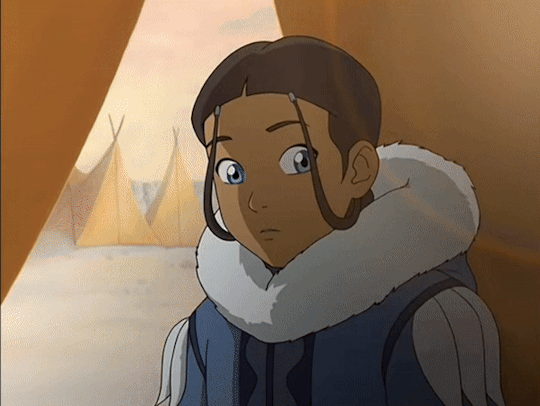
We see that she is intrigued and curious of him, and very excited about his presence. She is endeared and amused by his antics. She is rediscovering her childish side with his help. She is confiding in him about her own trauma surrounding the Fire Nation's genocide of the Southern Waterbenders. She is willing to go against her family and tribe ans leave them behind to go to the Northern Water Tribe with Aang. We also see her determination to save him when he is captured.
As the show moves on and the plot kicks into gear, we do shift more into Aang's perspective. We see his physical attraction to her, and while we don't see Katara's attraction quite as blatantly, there are hints of her interest in his appearance.

This is where we get deeper into the concept of Aang and Katara's mutual interest and attraction for one another. While her perspective is more subtle than most would like, Katara is not purely an object of Aang's desire, no more than he is purely an object of her desire.
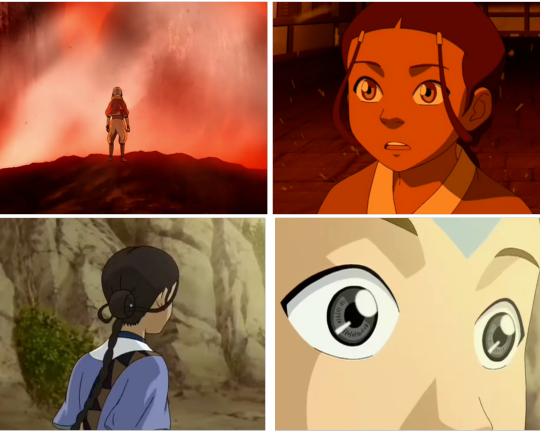
When analysing this aspect of Katara and Aang's relationship, I couldn't help but be reminded of how Célene Sciamma's Portrait of a lady on fire (in my personal opinion, one of the best studies of the female gaze ever created) builds up its romance, and how it places a strong emphasis on the mutuality of the female gaze.
Portrait of a lady on fire's cinematography is very important to the film. We see the world through the perspective of our protagonist, a painter named Marianne. We also see her love interest, Héloïse, the woman whom she is hired to paint a portrait of, through Marianne's lense.
We see Marianne analyse Héloïse's appearance, her beauty. We look purely through Marianne's eyes at Héloïse for a good part of the movie, but then, something unexpected happens. Héloïse looks back. At Marianne, therefore, in some way, also at the audience. While Marianne was studying Héloïse, Héloïse was studying Marianne.
We never shift into Héloïse's perspective, but we see and understand that she is looking back at us. Not only through her words, when she for example comments on Marianne's mannerisms or behaviours, but also hugely through cinematography and acting of the two amazing leads. (Noémie Merlant as Marianne and Adèle Haenel as Héloïse. They truly went above and beyond with their performances.)
This is a huge aspect of the female gaze's implementation in the film. The camera focuses on facial expressions, eyes and body language, seeking to convey the characters' emotions and feelings. There's a focus on intense, longing and reciprocated eye contact (I have dubbed this the Female Gays Gaze.). The characters stand, sit or lay facing each other, and the camera rarely frames one of them as taller than the other, which would cause a sense of power imbalance.
The best way to describe this method of flimaking is wanting the audience to see the characters, rather than to simply look at them. Sciamma wants us to empathise, wants us to feel what they are feeling, rather than view them from a distance. They are to be people, characters, rather than objects.
Avatar, of course, doesn't display the stunning and thoughtful cinematography of Portrait of a Lady on Fire, and Katara and Aang's relationship, while incredibly important, is only a part of the story rather than the focus of it.
However, the 'Kataang moments' we are privy to often follow a similar convention to the ones between Marianne and Héloïse that I mentioned prior.
Theres a lot of shots of Katara and Aang facing each other, close ups on their faces, particularly eyes, as they gaze at one another.
Katara and Aang are often posited as on equal grounds, the camera not framing either of them as much taller and therefore more powerful or important than the other. Aang is actually physically shorter than Katara, which flies in the face in usual conventions of the male fantasy. (I will get to Aang under the male gaze later in this essay)
And even in scenes when Aang is physically shown as above Katara, particularly when he's in the Avatar state, Katara is the one to pull him down, maintaining their relationships as equals.
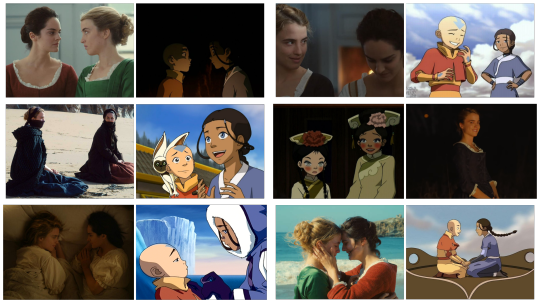
Despite most of the show being portrayed through Aang's eyes, Katara is not a passive object for his gaze, and therefore our gaze, to rest upon. Katara is expressive, and animated. As an audience, we are made aware that Katara has her own perspective. We are invited to take part in it and try to understand it.
Not unlike to Portrait of a Lady on Fire, there is a lot of focus placed on mannerisms and body language, an obvious example being Katara often playing with her hair around Aang, telegraphing a shy or flustered state. We also see her express jealousy over Aang, her face becoming sour, brows furrowed. On one occasion she even blew a raspberry, very clearly showing us, the audience, her displeasure with the idea of Aang getting attention from other girls.
Once again, this proves that Katara is not a passive participant in her own relationship, we are very clealry shown her perspective of Aang. Most of the scenes that hint at her and Aang's focus on their shared emotions, rather than, for example, Katara's beauty.
Even when a scene does highlight her physical appearance, it is not devoid of her own thoughts and emotions. The best example of this being the scene before the party in Ba Sing Se where we see Katara's looking snazzy in her outfit. Aang compliments her and Katara doesn't react passively, we see the unabashed joy light up her face, we can tell what she thinks of Aang's comment.
In fact, the first moment between Katara and Aang sets this tone of mutual gaze almost perfectly. Aang opens his eyes, and looks at Katara. Katara looks back.
There is, once again, huge focus on their eyes in this scene, the movement of Aang's eyelids right before they open draws out attention to that part of his face. When the camera shows us Katara, is zooms in onto her expression as it changes, her blinking also drawing attention to her wide and expressive eyes.

This will not be the first time emphasis is placed on Katara and Aang's mutual gaze during a pivotal moment in the show. Two examples off the top of my head would be the Ends of B2 and B3 respevtively. When Katara brings Aang back to life, paralleling the first time they laid eyes on one another. And at the end of the show, where their gaze has a different meaning behind it.
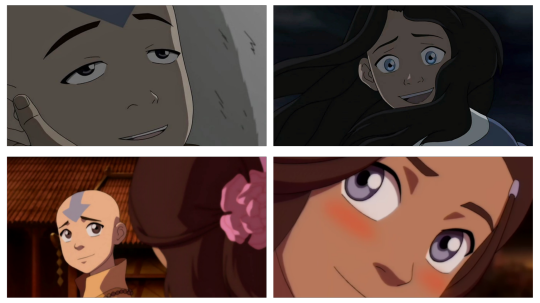
We see Katara's emotions and her intent telegraphed clearly in these instances.
In Book 1, we see her worry for this strange bald boy who fell out of an iceberg, which melts away to relief and a hint of curiosity once she ascertains that he isn't dead.
In B2 we once again see worry, but this time it's more frantic. Her relationship with Aang is much dearer to her heart now, and he is in much worse shape. When we see the relief on her face this time, it manifests in a broad smile, rather than a small grin. We can clearly grasp that her feelings for Aang have evolved.
In B3, we step away from the rule because Aang isn't on the verge of death or unconsciousness for the first time. It is also the first time in a situation like this that Aang isn't seeing Katara from below, but they are on equal footing. I attribute this to symbolising change of pace for their relationship.
The biggest obstacle in the development of Katara and Aang's romance was the war, which endangered both their lives. Due to this, there was a hesitance to start their relationship. In previous scenes that focused this much on Aang and Katara's mutual gaze, Aang was always in a near dead, or at least 'dead adjacent' position. This is is a very harsh reminder that he may very well die in the war, and the reason Katara, who has already endured great loss, is hesitant to allow her love for him to be made... corporeal.
However, now Aang is standing, portraying that the possibily of Katara losing him has been reduced greatly with the coming of peace, the greatest obstacle has been removed, and Katara is the one to initiate this kiss.
Concurrently, Katara's expression here does not portray worry or relief at all, because she has no need to be worried or relieved. No, Katara is blushing, looking directly at Aang with an expression that can be described as a knowing smile. I'd argue that this description is accurate, because Katara knows that she is about to finally kiss the boy she loves.
Ultimately, Katara is the one who initiates the kiss that actually begins her and Aang's romantic relationship.
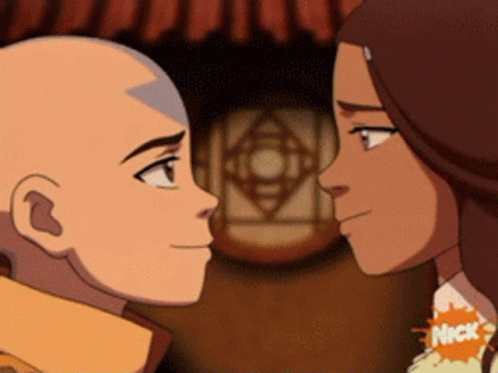
Kataang's appeal to women is reflected in how Katara is almost always the one to initiate physical affection with Aang. With only 3 exceptions, one of which, the Ember Island kiss being immediately shown by the narrative as wrong, and another being a daydream due to Aang's sleep deptivation. The first moment of outwardly romantic affection between Aang and Katara is her kissing his cheek. And their last kiss in the show is also initiated by Katara.
I won't falsely state that Kataang is the perfect representation of the female gaze. Not only because the storyline has its imperfections, as every piece of media has. But also because I simply belive that the concept of the female gaze is too varied and nebulous to be fully expressed. With this essay, I simply wanted to prove that Kataang is most certainly not the embodiment of catering to the male gaze either. In fact it is quite far from that.
The aspects of Kataang that fall more towards embodying the female gaze don't just appeal to women. There's a reason a lot of vocal Kataang shippers you find are queer. The mutual emotional connection between Katara and Aang is something we don't have to identify with, but something we are still able to emphasise with. It's a profound mutual connection that we watch unfold from both perspectives that sort of tracends more physical, gendered aspects of many onscreen romances. You just need to see instead of simply look.
✨️Bonus round✨️
Aang under the gaze
This started off as a simple part of the previous essay, however I decided I wanted to give it it's own focus, due to the whole discourse around Aang being a wish-fullfilling self insert for Bryke or for men in genral. I always found this baffling considering how utterly... unappealing Aang is to the male gaze.
It may surprise some of you that men are also subjected to the male gaze. Now sadly, this has nothing to do with the male gaze of the male gays. No, when male characters, usually the male protagonist, are created to cater to the male gaze, they aren't portrayed as sexually desirable passive objects, but they embody the active/masculine aide of the binary Laura Mulvey spoke of in the quote I shared at the beginning of this essay.
The protagonist under the male gaze is not the object of desire but rather a character men and boys would desire to be.
They're usually the pinnacle of traditional, stereotypical masculinity.
Appearance wise: muscular but too broad, chiseled facial features, smouldering eyes, depending on the genre wearing something classy or some manner of armour.
Personalitywise they may vary from the cool, suave James Bond type, or a more hotblooded forceful "Alpha male" type. However these are minor differences in the grand scheme of things. The basis is that this protagonist embodies some manner of idealised man. He's strong, decisive, domineering, in control, intimidating... you get the gist. Watch nearly any action movie. There's also a strong focus placed on having sway or power over others. Often men for the male gaze are presented as wealthy, having power and status. Studies (that were proved to be flawed in the way the data was gathered, I believe) say that womem value resources in potential male partners, so it's not surprising that the ideal man has something many believe would attract "mates". [Ew I hated saying that].
Alright, now let's see how Aang holds up to these standards.

Well... um...
Aang does have power, he is the Avatar. However, he is often actually ignored, blown off and otherwise dismissed, either due to his age or his personality and ideals being seen as unrealistic and foolish. Additionally, Aang, as a member of a culture lost a century ago, is also often posited as an outsider, singled out as weak, his beliefs touted as the reason his people died out and.
Physically, Aang doesn't look like the male protagonist archetype, either. He isn't your average late teens to brushing up against middle aged. Aang is very much a child and this is reflected in his soft round features, large eyes and short, less built body. This is not a build most men would aspire to. Now, he still has incredible physical prowess, due to his bending. But I'm not sure how many men are desperate to achieve the "pacifist 12 year old" build to attract women.
Hailing from a nation that had quite an egalitarian system, Aang wouldn't have conventional ideas surrounding leadership, even if he does step up into it later. He also has little in the way of possessions, by choice.
As for Aang's personality, well...

I mean I wouldn't exactly call him your average James Bond or superhero. Aang is mainly characterised through his kindness, empathy, cheerful nature and occasional childishness (which slowly is drained as the trauma intesifies. yay.)
Aang is very unwilling to initiate violence, which sets him aside from many other male protagonists of his era, who were champing at the bit to kick some ass. He values nature, art, dance and fun. He's in tune with his emotions. He tries to desecalate situations before he starts a fight.
Some would say many of Aang's qualities could be classified as feminine. While the other main male characters, Zuko and Sokka try to embody their respective concepts of the ideal man (tied to their fathers), Aang seems content with how he presents and acts. He feels no need to perform masculinity as many men do, choosing to be true to his emotions and feelings.
These "feminine" qualities often attract ridicule from other within the show. He is emasculated or infantiliased as a form of mockery multiple times, the most notable examples being the Ember Island play and Ozai tauntingly referring to him as a "little boy". Hell, even certain Aang haters have participated in this, for example saying that he looks like a bald lesbian.
I'd even argue that, in his relationships with other characters, Aang often represents the passive/feminine. Especially towards Zuko, Aang takes on an almost objectified role of a trophy that can be used to purchase Ozai's love. [Zuko's dehumanisation of others needs to be discussed later, but it isn't surprising with how he was raised and a huge part of his arc is steerring away from that way of thinking.]
Aang and Zuko almost embody certain streotypes about relationships, the forceful, more masculine being a literal pursuer, and the gentler, more feminine being pusued.
We often see Aang framed from Zuko's perspective, creating something akin to the mutual gaze of Katara and Aang, hinting at the potential of Zuko and Aang becoming friends, a concept that is then voiced explicitly in The Blue Spirit.
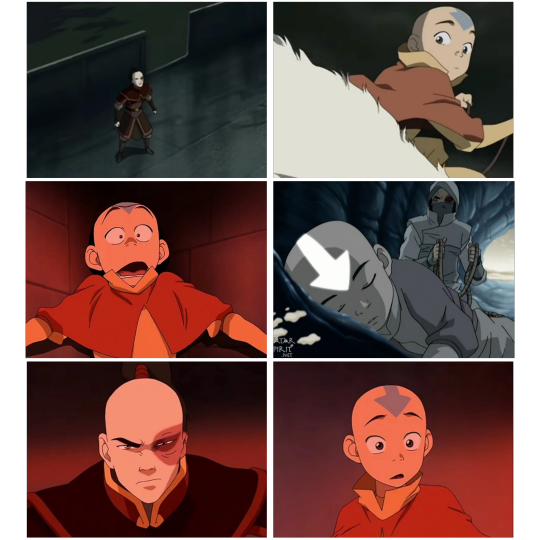
However, unlike Katara, Zuko is unable to empathise with Aang at first, still seeing Aang as more of an object than a person. We have here an interesting imbalance of Aang seeing Zuko but Zuko meerly looking at Aang.
There is a certain aspect of queer metaphor to Zuko's pursuit of Aang, but I fear I've gotten off topic.
Wrapping this long essay up, I want to reiterate that I'm not saying that Zutara isn't popular with women. Most Zutara shippers I've encountered are women. And most Kataang shippers I've encountered are... also women. Because fandom spaces are occupied predominantly by women.
I'm not exactly making a moral judgement on any shippers either, or to point at Kataang and go: "oh, look girls can like this too. Stop shipping Zutara and come ship this instead."
I want to point out that the juxtaposition of Zutara and Kataang as respectively appealing to the feminine and masculine, is a flawed endeavour because neither ship does this fully.
The concept of Kataang being a purely male fantasy is also flawed due to the points I've outlied in this post.
Are there going to be male Kataang shippers who self insert onto Aang and use it for wish fulfilment? Probably. Are there going to be male Zutara shippers who do the same? Also probably.
In the end, our interpretation of media, particularly visual mediums like film are heavily influenced by our own biases, interests, beliefs andmost importantly our... well, our gaze. The creators can try to steer us with meaningful shots and voiced thought, directing actors or animating a scene to be a certain way, but ultimately we all inevitably draw our own conclusions.
A fan of Zutara can argue that Kataang is the epitome of catering to the male gaze, while Zutara is the answer to women everywhere's wishes.
While I can just as easily argue the exact opposite.
It really is just a matter of interpretation. What is really interesting, is what our gaze says about us. What we can see of ourselves when the subject gazes back at us.
I may want to analyse how Zutara caters to the male gaze in some instances, if those of you who manage to slog through this essay enjoy the subject matter.
#ok getting off my soapbox#i forgot how much i love to write these long sprawling essays...#kataang#pro kataang#aang#pro aang#aanglove#aang defense squad#pro katara#katara defense squad#kataang love#zuko#avatar#atla#avatar: the last airbender#the last airbender#avatar the last airbender#aang the last airbender#anti zutara
456 notes
·
View notes